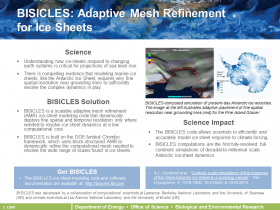BISICLES: Adaptive Mesh Refinement for Ice Sheets
BISICLES is an ice sheet model that uses adaptive mesh refinement (AMR) to enable fully-resolved modeling of the marine ice sheet dynamics found in Antarctica and Greenland.
On average, Earth’s glaciers and ice sheets are shrinking. It is estimated that Antarctica holds about 70 percent of the world’s freshwater and 90 percent of the total global ice mass, while Greenland contains much of the remaining 10 percent. Understanding how these huge ice reserves respond to changing earth systems is critical for projections of sea-level rise in the 21st century and beyond.
The Department of Energy’s Ice Sheet Initiative for Climate Extremes (ISICLES) was initiated by the Advanced Scientific Computing Research (ASCR) Office after a 2007 international call for better projections of potential ice sheet contribution to global sea-level rise. An extension of this effort, BISICLES today is jointly supported by DOE’s Office of Advanced Scientific Computing Research (ASCR) and Office of Biological and Environmental Research (BER), and offers researchers scalable AMR ice-sheet modeling tools.
It is a scalable model built on the DOE-funded Chombo software framework, which uses block-structured AMR to dynamically refine the computational mesh needed to resolve the wide range of scales found in ice sheets. In dynamic refinement, the mesh adjusts during the simulation to place high-resolution where the sheet is changing most rapidly.
BISICLES will be fully coupled to DOE’s Energy Exascale Earth System Model (E3SM) model version 3.


